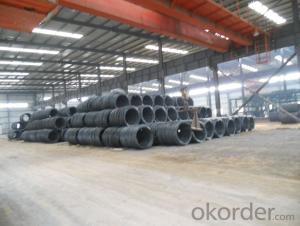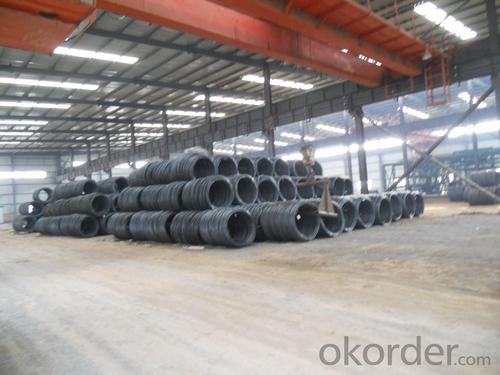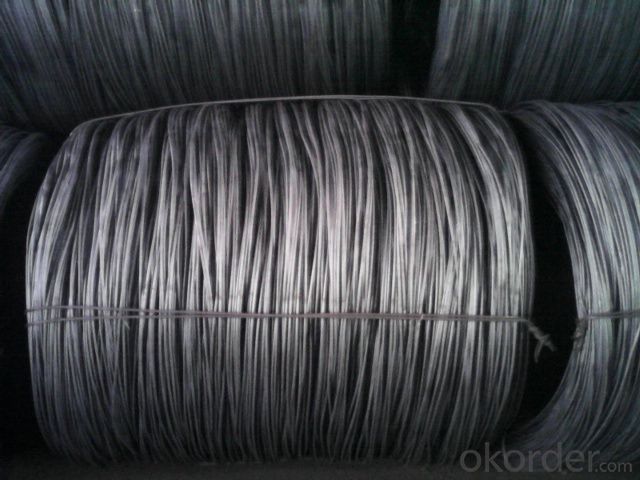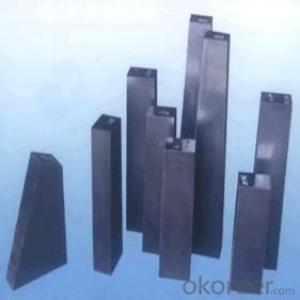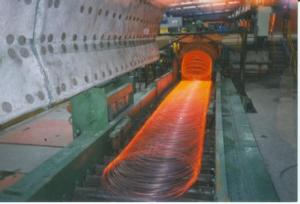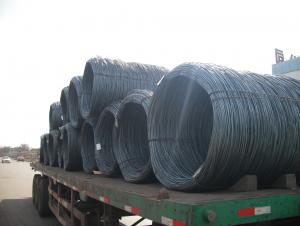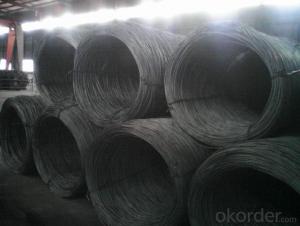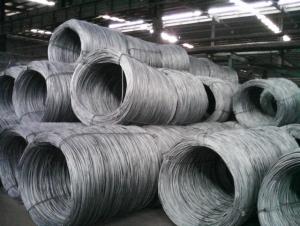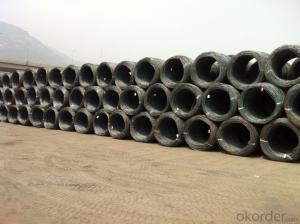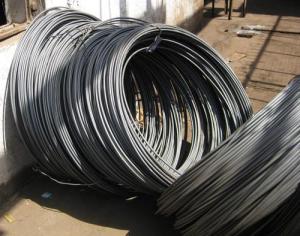Hot Rolled Steel Wire Rod GB/JIS/ASTM/DIN High Qulity
- Loading Port:
- Tianjin
- Payment Terms:
- TT OR LC
- Min Order Qty:
- 500 m.t.
- Supply Capability:
- 30000 m.t./month
OKorder Service Pledge
OKorder Financial Service
You Might Also Like
Specification
Product Description:
OKorder is offering Hot Rolled Steel Wire Rod GB/JIS/ASTM/DIN High Qulity at great prices with worldwide shipping. Our supplier is a world-class manufacturer of steel, with our products utilized the world over. OKorder annually supplies products to European, North American and Asian markets. We provide quotations within 24 hours of receiving an inquiry and guarantee competitive prices.
Product Applications:
Hot Rolled Steel Wire Rod GB/JIS/ASTM/DIN High Qulity are ideal for structural applications and are widely used in the construction of buildings and bridges, and the manufacturing, petrochemical, and transportation industries.
Product Advantages:
OKorder's Hot Rolled Steel Wire Rod GB/JIS/ASTM/DIN High Qulity are durable, strong, and resist corrosion.
Main Product Features:
· Premium quality
· Prompt delivery & seaworthy packing (30 days after receiving deposit)
· Corrosion resistance
· Can be recycled and reused
· Mill test certification
· Professional Service
· Competitive pricing
Product Specifications:
Steel Grade: Q195 Standard: ASTM, GB
Diameter: 5.5mm, 6.5mm, 7mm,8mm,9mm,10mm,12mm,14mm
6.5mm can be drawing into 2mm/8.0mm can be drawing into 3mm
Type: Drawn Wire in Coil, each coil weight about 2MT
Brand Name: N-RIVER Place of Origin: Hebei, China
Chemical Composition:
Please kindly find our chemistry of our material based on Q195 as below for your information
Trademark | Rank | Chemical composition (quality score) % | ||||||
C | Si | Mn | S | P | ||||
| ≤ |
| ≤ | ≤ | ||||
Q195 |
| 0.06-0.12 | 0.30 | 0.25 | 0.050 | 0.045 | ||
Q235 | A | 0.14-0.22 | 0.30 | 0.30-0.65 | 0.050 | 0.045 | ||
Q235 | B | 0.12-0.20 | 0.30 | 0.30-0.70 | 0.045 | 0.045 | ||
Packaging & Delivery of Wire Rod SAE1008B:
Packaging Detail: products are packed in coil and then shipped by container or bulk vessel
Each coil weight: 2-3MT
Delivery Detail: within 45 days after received deposit or LC.
Label: to be specified by customer, generally, each bundle has 1-2 labels
Trade terms: CFR, CIF
FAQ:
Q1: Why buy Materials & Equipment from OKorder.com?
A1: All products offered byOKorder.com are carefully selected from China's most reliable manufacturing enterprises. Through its ISO certifications, OKorder.com adheres to the highest standards and a commitment to supply chain safety and customer satisfaction.
Q2: How do we guarantee the quality of our products?
A2: We have established an advanced quality management system which conducts strict quality tests at every step, from raw materials to the final product. At the same time, we provide extensive follow-up service assurances as required.
Q3: How soon can we receive the product after purchase?
A3: Within three days of placing an order, we will begin production. The specific shipping date is dependent upon international and government factors, but is typically 7 to 10 workdays.
Q4: What makes stainless steel stainless?
A4: Stainless steel must contain at least 10.5 % chromium. It is this element that reacts with the oxygen in the air to form a complex chrome-oxide surface layer that is invisible but strong enough to prevent further oxygen from "staining" (rusting) the surface. Higher levels of chromium and the addition of other alloying elements such as nickel and molybdenum enhance this surface layer and improve the corrosion resistance of the stainless material.
Q5: Can stainless steel rust?
A5: Stainless does not "rust" as you think of regular steel rusting with a red oxide on the surface that flakes off. If you see red rust it is probably due to some iron particles that have contaminated the surface of the stainless steel and it is these iron particles that are rusting. Look at the source of the rusting and see if you can remove it from the surface.
Images:

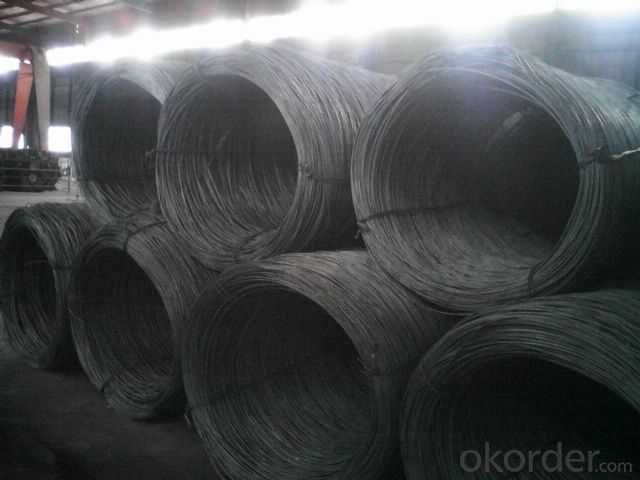
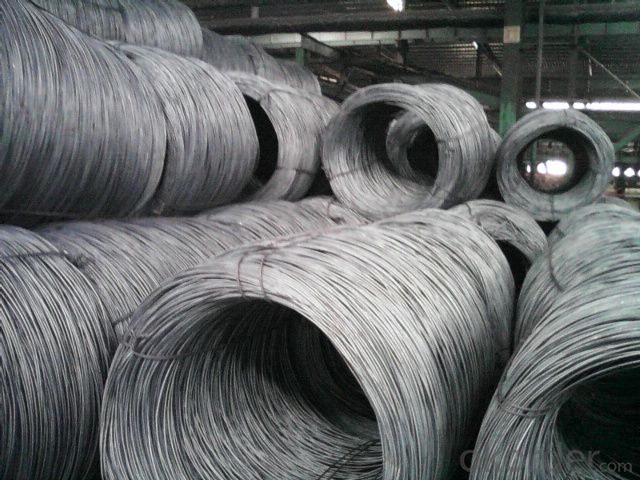
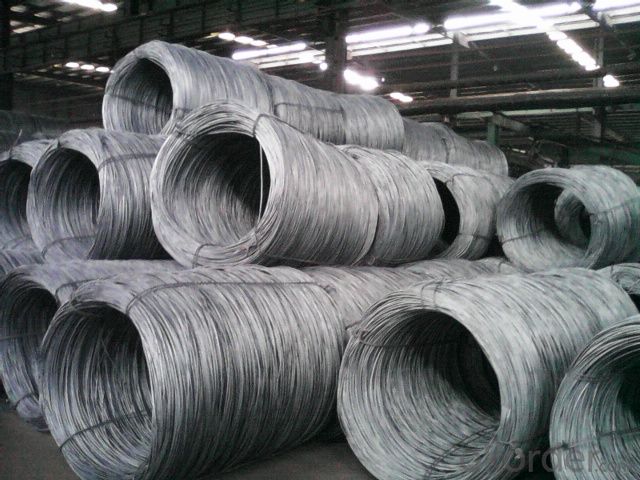
- Q: What are the common production processes for actinium-coated steel wire rod?
- The common production processes for actinium-coated steel wire rod generally include wire drawing, cleaning, coating, curing, and packaging.
- Q: What are the standard tensile strength requirements for steel wire rod?
- The standard tensile strength requirements for steel wire rod vary depending on the specific grade and application. However, commonly used steel wire rods typically have a tensile strength range of 400 to 1000 megapascals (MPa).
- Q: How is steel wire rod used in the manufacturing of suspension cables for bridges?
- Steel wire rod is an essential component in the manufacturing of suspension cables for bridges due to its high strength and durability. Suspension cables are responsible for supporting the weight of the bridge deck and transferring the load to the bridge towers or anchorages. In the manufacturing process, steel wire rods are first subjected to a series of heat treatments to enhance their mechanical properties. This includes processes like annealing, which softens the steel and makes it more malleable, and quenching and tempering, which increases its strength and toughness. These treatments ensure that the wire rods can withstand the high tension and stress that suspension cables are exposed to. Once the wire rods are properly treated, they are further processed into wire strands by twisting several wire rods together. These wire strands are then tightly wrapped around a central core, forming the main body of the suspension cables. The number of wire strands and their arrangement may vary depending on the design and load requirements of the bridge. The use of steel wire rod in suspension cables offers numerous advantages. Its high tensile strength allows the cables to resist the substantial forces exerted on the bridge, such as the weight of the deck, live loads, wind loads, and seismic forces. The durability of steel wire rod ensures that the suspension cables can last for decades without significant degradation, providing long-term structural integrity to the bridge. Moreover, steel wire rod is highly resistant to corrosion, making it suitable for outdoor applications, even in harsh environments. This corrosion resistance is crucial for suspension cables, as they are constantly exposed to environmental factors such as moisture, humidity, and temperature fluctuations. By using steel wire rod, the risk of deterioration and failure due to corrosion is significantly reduced, ensuring the safety and longevity of the bridge. In conclusion, steel wire rod plays a vital role in the manufacturing of suspension cables for bridges. Its strength, durability, and corrosion resistance make it an ideal material for withstanding the high tension and stress exerted on the cables. By using steel wire rod, suspension cables can provide the necessary support to bridges, ensuring their structural integrity and safety for years to come.
- Q: How are steel wire rods used in the production of reinforcements for concrete?
- The production of reinforcements for concrete heavily relies on steel wire rods. Utilizing high-quality steel, these wire rods undergo a process known as hot rolling to be manufactured. Within the realm of concrete reinforcement production, steel wire rods serve as the building blocks for various types of reinforcements. Wire mesh, rebar, and welded wire fabric are among the creations resulting from these rods. These reinforcements are incorporated into concrete structures to bolster their strength, endurance, and resistance against cracks. To fashion wire mesh, steel wire rods undergo initial straightening, followed by cutting into desired lengths. Subsequently, these lengths are welded together, forming a grid-like pattern. Within the concrete structure, the wire mesh contributes tensile strength, effectively preventing the formation and propagation of cracks. Rebar, another prevalent reinforcement, involves bending and cutting steel wire rods into specific shapes and sizes. These rebars find their place embedded within the concrete, offering structural support and fortifying the concrete against tension forces. Columns, beams, and slabs frequently employ rebars to ensure the soundness of concrete structures. Steel wire rods can also be utilized in the production of welded wire fabric, which constitutes intersecting steel wires. At the points of intersection, the wires are welded together, generating a resilient mesh. Welded wire fabric frequently finds application in larger concrete structures like bridges and highways, effectively distributing loads and averting cracks. In summary, steel wire rods occupy a crucial role in the realm of concrete reinforcement production. By supplying the requisite strength, durability, and crack resistance, these rods guarantee the stability and longevity of concrete structures.
- Q: What are the different impact testing methods for steel wire rod?
- To evaluate the mechanical properties of steel wire rods, there are multiple impact testing methods available. These methods are essential in determining the wire rods' ability to withstand sudden impact or shock loading, which is crucial in industries like construction, automotive, and aerospace. Some commonly used impact testing methods for steel wire rods are as follows: 1. Charpy Impact Test: This method involves striking a notched or V-notch specimen with a pendulum hammer to measure the energy absorbed during fracture. It provides a measure of the material's toughness and is widely preferred for its simplicity and ease of implementation. The results are typically reported in joules. 2. Izod Impact Test: Similar to the Charpy test, the Izod test also measures the energy absorbed during fracture. However, in this method, the specimen is clamped vertically, and the pendulum strikes it on the opposite side of the notch. This test assesses the material's resistance to sudden impact. 3. Drop Weight Test: This method involves dropping a weight from a specified height onto a wire rod specimen. The energy absorbed during fracture is measured, allowing for the evaluation of the material's impact resistance under specific conditions. 4. Dynamic Tear Test: This test evaluates the fracture toughness of steel wire rods by measuring the energy required to propagate a pre-existing crack through the specimen. A load is applied to the specimen using either a pendulum or a hydraulic system, and the crack propagation is monitored. 5. Ballistic Pendulum Test: This method determines the velocity of a small projectile before and after it strikes the wire rod specimen. By measuring the change in velocity, the impact resistance of the material can be evaluated. This test is commonly used for high-strength steel wire rods. Each impact testing method has its own strengths and limitations, and the selection of the appropriate method depends on factors such as the specific application, material properties, and test requirements. It is crucial to choose a testing method that accurately reflects the intended use of the steel wire rod, ensuring its performance and reliability in real-world scenarios.
- Q: What is the diameter of steel wire and the diameter of wire rod, and what's their difference?
- Steel wire is pulled by wire rod, the diameter of wire rod is the diameter of billet line, that is, the diameter before drawing. The diameter of steel wire is the diameter of wire rod drawn into steel wire
- Q: How is the steel wire rod market impacted by technological advancements?
- Technological advancements have significantly impacted the steel wire rod market by revolutionizing the manufacturing process, improving product quality, and enhancing operational efficiency. Advanced manufacturing techniques such as automation, robotics, and data analytics have streamlined production, leading to higher productivity and reduced costs. Furthermore, technological advancements in metallurgy and material science have resulted in the development of stronger and more durable wire rods, meeting the evolving demands of various industries. Additionally, innovations in wire rod coatings and surface treatments have expanded the range of applications and improved corrosion resistance. Overall, technological advancements have played a crucial role in shaping the steel wire rod market, driving growth, and enabling manufacturers to stay competitive in a rapidly changing industrial landscape.
- Q: How is steel wire rod used in the production of wire mesh for agricultural applications?
- Steel wire rods are used in the production of wire mesh for agricultural applications by being drawn through a series of dies to reduce their diameter, resulting in wire of the desired thickness. This wire is then woven or welded together to form a mesh, which is used for various agricultural purposes such as securing fences, creating cages for livestock, and constructing trellises for plants. The strength and durability of steel wire rods make them ideal for withstanding the harsh conditions and heavy loads often encountered in agricultural settings.
- Q: What are the common industry regulations for steel wire rod?
- The common industry regulations for steel wire rod include specifications for chemical composition, mechanical properties, size tolerances, surface defects, and packaging requirements. These regulations ensure that the steel wire rod meets the required standards for quality and safety in various applications such as construction, manufacturing, and automotive industries.
- Q: How is the surface quality of steel wire rod assessed?
- The surface quality of steel wire rod is typically assessed through visual inspection, using various methods such as magnification, lighting, and surface profiling techniques. Additionally, non-destructive testing methods like magnetic particle inspection or ultrasonic testing may be employed to detect any surface defects or irregularities.
Send your message to us
Hot Rolled Steel Wire Rod GB/JIS/ASTM/DIN High Qulity
- Loading Port:
- Tianjin
- Payment Terms:
- TT OR LC
- Min Order Qty:
- 500 m.t.
- Supply Capability:
- 30000 m.t./month
OKorder Service Pledge
OKorder Financial Service
Similar products
Hot products
Hot Searches
Related keywords
